Monywa is small town (136km) just 2 hours drive from Mandalay and 3 hours drive from Bagan. As Monywa is not far from Mandalay, day return tour to Monywa is recommendable. Another option is overnight at Monywa for first day and then proceeds to Bagan on Second day. Having more time gets lovely chance to visit around Monywa and beautiful cultural tour during your drive to Bagan.
Monywa is the most important city towards the western gate of Myanmar. The city is situated on the eastern bank of Chindwin River. The town is important trade center for agricultural product around Chindwin Valley. Cotton blanket, Seik Khon cotton longyi for both men and women are famous products of Monywa region. It has tropical climate. Nice temperature during winter time (December to February), the rest of the year is hot, dry and dusty.
According to local legend, the name Monywa comes from “Mont Ywa” means the village of Mont (Mont means Myanmar traditional rice cake). In the past time the king fell in love with a lady who was rice cake seller of the village and made her his queen. The original name is Mont Ywa, Thanlawadi is its classical name. During the time of Bagan monarch, there was a big village at the place of Monywa.
What to see around Monywa
Thanbodhay temple
Monywa Bodhitataung
Powin cave or Powin Taung
Kyaukka village and Shweguni pagoda
Monywa Mau Kyi village (snack village)
Mau ale village
Thet village – Pottery village
Yezagyo village
Most travelers use to drive from Mandalay to Monywa and pass small town called Myinmu, which has lovely colorful authentic local market. It is interesting place for travelers who love to see smiling Myanmar. There are hundreds acres of cultivated land for dry crops and betel leaves. After driving an hour, one of the options is visiting to one of the families who make rice noodle in traditional way. It is also lovely to see how Myanmar makes local sweet and snack at home.
Thanbodhay temple
“Thanbodhay” is a first phrase of Buddhist praying means “May I pray uncountable Buddha”. Thanbodhay Temple lies 8 miles from Monywa which is house of 582,000 Buddha images built in the year 1939 after a venerable Buddhist monk back from Indonesia completed in the year 1952. The colorful modern temple was built model on Borobudur temple of Indonesia. The long walkway from entrance to main shrine of temple, there are many columns with big standing Buddha images, huge sitting Buddha images and very tiny Buddha images. Many altars are with elegance plinth and unique decoration of stucco in floral pattern. Each altar rarely mentioned the name of artist and his native. The interior walls and columns of the temples are decorated with numerous tiny Buddha images.
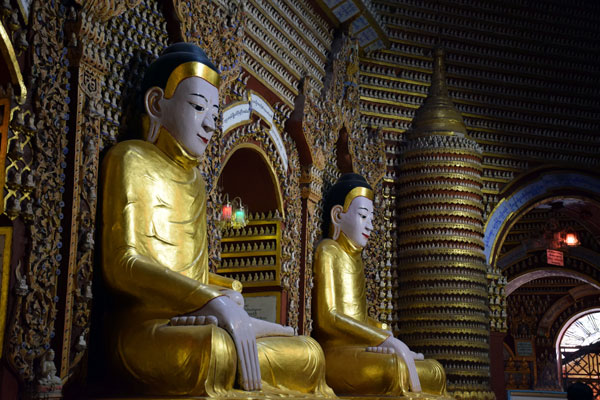
Outside of the main temple, huge pillars are decorated with colorful fruit trails made of stucco: branches of banana, papaya, mangoes, watermelon.
There is a tower only men are allowed to go up for panorama over main temple and around. At the base there are niches with stucco statues narrate about life history of Gautama Buddha.
Close to that tower there is a column with the monk statue on the top and a group of royal family with the king at the base which narrates lovely story of supernatural power of the monk.
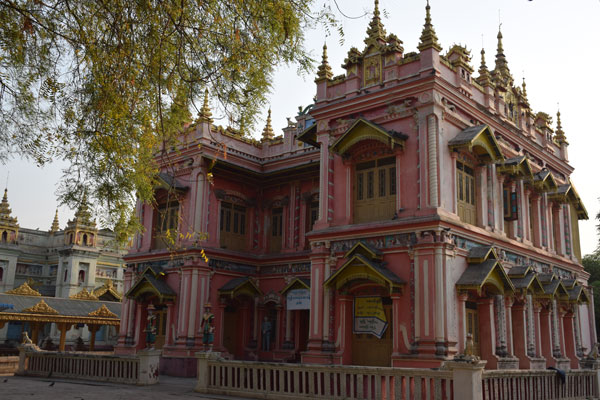
Lion statues are widely known as guards of Pagoda in Myanmar and use to place at the entrance of the pagoda. Unlike other pagodas in Myanmar, two elephant statues are the guard of Thanbodhay temple.
There are many other buildings: some are wooden bungalows, some are colonial style brick buildings are used as guest houses during Thanbodhay pagoda festival that used to fall in November.
Thanbodhay pagoda festival attracts pilgrims from throughout the country. As other famous annual pagoda festival, it is similar in nature to agricultural shows and very important part of cultural life in Myanmar. There are temporary food stalls and stands and performance for entertainment. Admission fees for foreign visitor is 3000Kyats per person.
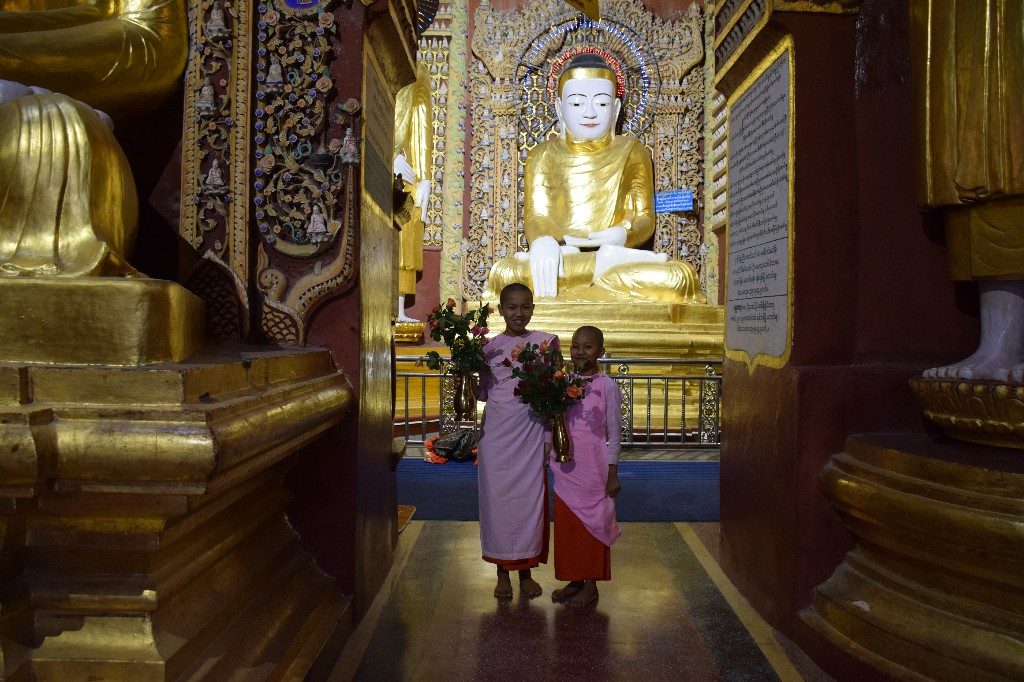
Bodhitataung
Few minutes drive from Thanbodhay temple there is Bodhitataung monastery. Founder of Bodhitataung monastery well-known as Bodhitataung Sayadaw is the first donator or who started to plant Bodhitataung – thousand of Bo Trees (ficus religiousa). Each tree has a sitting Buddha image underneath. Numerous Bo trees are planted every year and there is green forest of Bo tree around. Beginning of 1900, it was hot, dry and difficult place for cultivation at the base of Pho Khaung Taung. Not only for religious evidence, for environmental care and protection, planted acres of Ficus religiousa makes a pleasant, peaceful place filled with the song of birds where nature and men are in perfect harmony.
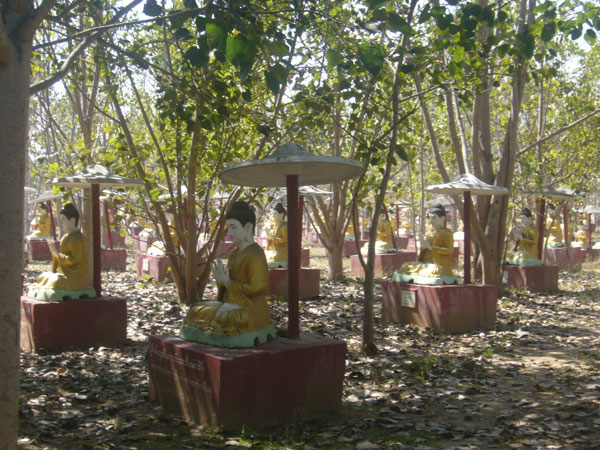
Shwethalaung reclining Buddha
90 meter long Shwethalaung reclining Buddha image built in 1991 is on the slope of the hill. It is hollow and cave like structure, can walk inside from the head to the feet. It is also the gallery of the stucco and brick statues that narrate life story of Gautama Buddha from his birth to Nibana.
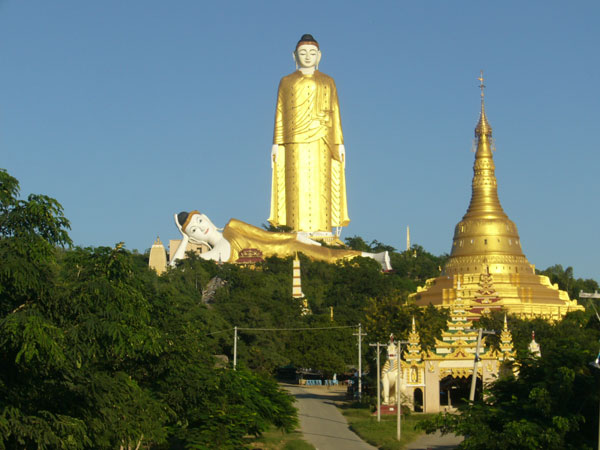
Laykyun sekkya standing Buddha
116 meters high Laykyun sekkya standing Buddha built in 1995 is just few mile back of reclining Buddha.
Aung Sakkya Pagoda
It is recommendable to go up Aung Sakkya Pagoda built in 1979 for wide panorama
Powin cave or Powin Taung
Powin Taung has different spellings: Powun daung, Hpowin taung, Po Win Daung etc….
It also has different meanings:
“Hill to mature on the way to Nibbana” refers to the hill as a religious place where monks, hermits and lay devotees have come to meditate for many centuries.
Another version is Hill of Pho Win, refers to an alchemist, with supernatural powers call U Pho Win, whose name was given to the hill.
Po Win taung also means Hill of alchemists, the hill as a place where alchemists worked and practice alchemy.
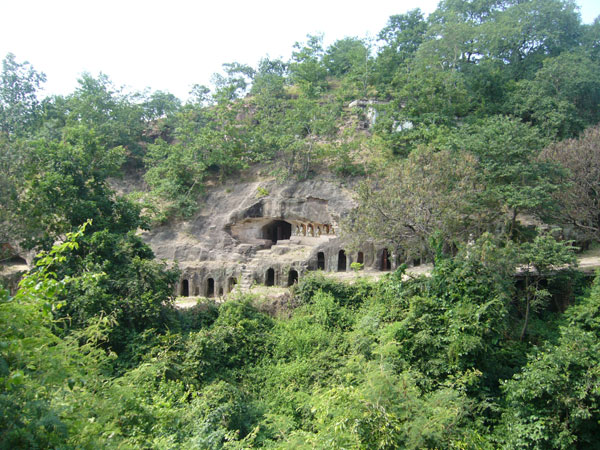
There are around 800 caves and 500 caves are visitable. The caves contain Buddha statues and Mural date back to 17th and 18th century. Some are 14th to 16 century.
The historical origin of the Buddhist Rock site of Powin Taung is unknown. As there is no written documents, there is no answer for who started to make the first Buddhist cave of Powin Taung. According to typology of the cave, we can understand the nature of the site and its function.
The caves were dug over several periods from 14th to late 20th century. The oldest caves were not intended to shelter monks as they are small and has narrow path between the rows of Buddha statues. These caves were built for praying, meditating and educating.
The unique feature of murals at Powin Taung is in man-made caves and not in building.
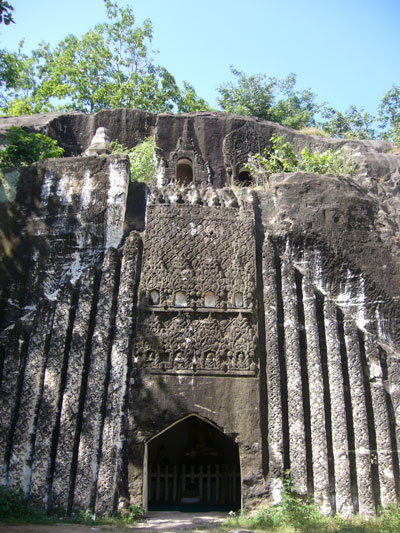
The caves have been dug into a sandstone formation consisting of three types of rocks: sandstone, tuffaceous sandstone and ferruginous sandstone.
The cavities dug in the rock range from a single niche to a network of galleries. Some of the wall neighboring caves are so thin and accidentally perforated.
There are different forms of caves:
Quadrangular caves are either square or rectangular, there are two types, single-room caves and caves with several interconnected rooms. The main images of the caves are always sitting Buddha sculpted in the back wall facing the entrance.
The connection between the rooms of some caves seem to have been made later.
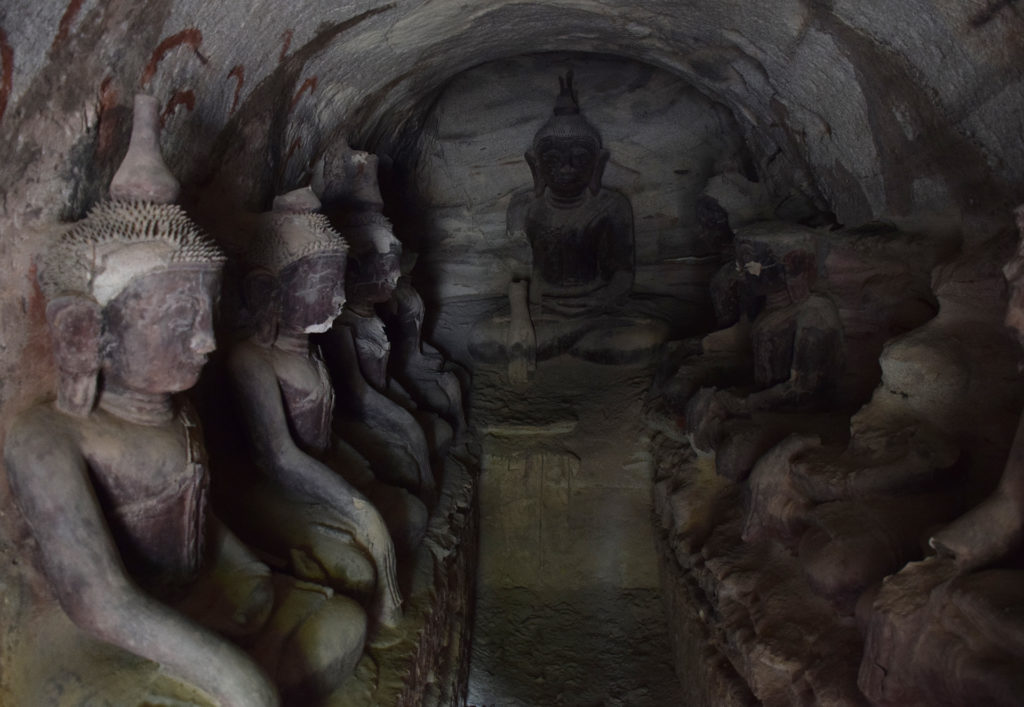
Caves with a central image, in the middle of the cave it is just a column made from native rock with four Buddha images.
Caves with galleries: can be single gallery or orthogonal gallery. Single gallery caves have been dug parallel to the massif and Buddha images were curved in the native rock of the wall.
Some caves dug during the colonial period under British administration. The entrance of the building made of stone blocks covered with stucco reliefs that show European influences.
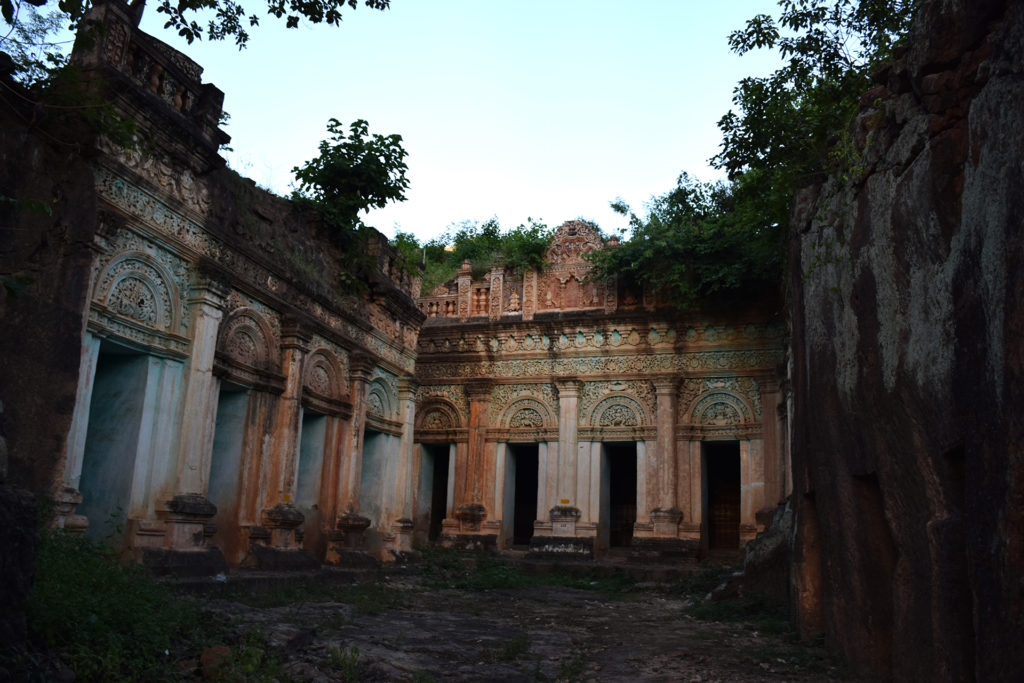
Caves were donated by different donors in different period. It seems the caves are not as a place cult, donor intended to get merit as some caves are very small and just like the niches around the sandstone mountain. There is no unity at the several caves because they were donated by several donors. Some caves were left incomplete. Some have murals around only some of their entrances. The site of Po Win evolved with the flow of donations, no master plan.

Po Win village
There is Po Win village with a population of five hundred people near the caves. December is the month they held Po Win Taung annual pagoda festival. Like other pagoda festivals, food stalls, local product sellers especially Myanmar Thanakha, sandalwood, woven textiles can be bought at the various stalls.
Shwe Ba Taung
1 km from Po Win Taung there is another man made caves Shwe Ba Taung rock site date from the colonial area is also recommendable to visit if you have enough time.
How to get Po Win Taung
Just one hour drive from Monywa by private car.
Another option is take the boat at the jetty to cross Chindwin River for 10 minutes. Hire Jeep or pickup at the other bank of the river to Po Win Taung.
Kyaukka village and Shweguni pagoda
Shweguni pagoda is one of the interesting places around Monywa which lies 20 miles from Monywa. It was known as Kyaukka Shweguni pagoda. The Buddha image lost the original face as many devotees offer (stick) gold leaves not only on the body as well as at the face of image.
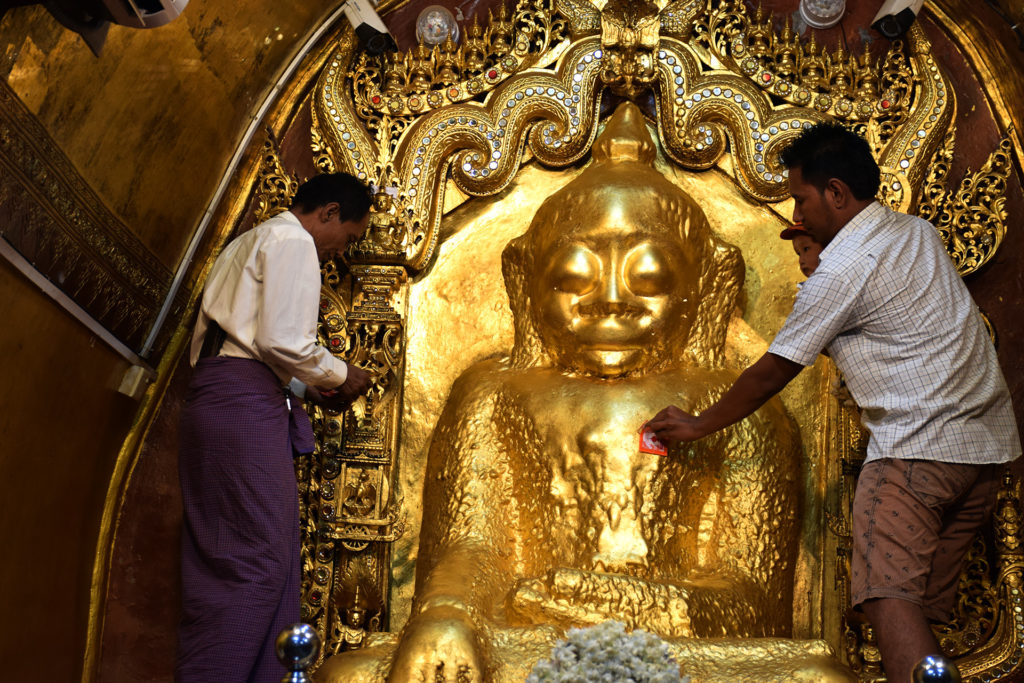
Kyauk Ka Village
Kyauk Ka Village is just near the Shweguni pagoda. Big village was well known for black lacquare called Kyaukka ware next to Bagan lacquare.
Mau Kyi village
Just half an hour drive from Monywa, next to toll gate, turn to right follow along the narrow road there is a village famous for local snack that we find at local market around Monywa. Most villagers are farmers with traditional long leg wooden houses. As soon as enter to the village get smell of baking something as some villagers make toasted peanut, sunflower, toasted peanut with harder skin, toasted tamarind seed, fried beans, fried peas, toasted peas ….

Mau ale village
One of the villages in the group of Mau 9 villages which lies between Monywa and Bagan. Ruins of Mau ale, 19th religious buildings are on the right side of the village as soon as turn to left from main road. Follow the lane walking among the neglected temples is part of the beauty of Mau ale village. Circular lane will bring you to the village. Bamboo balance, bamboo baskets and incense are its products. Some families still keep traditional deep well for family water supply. Walking along the central road will bring you to charming Mau ale wooden bridge crossing the big lake surrounded by group of palms.
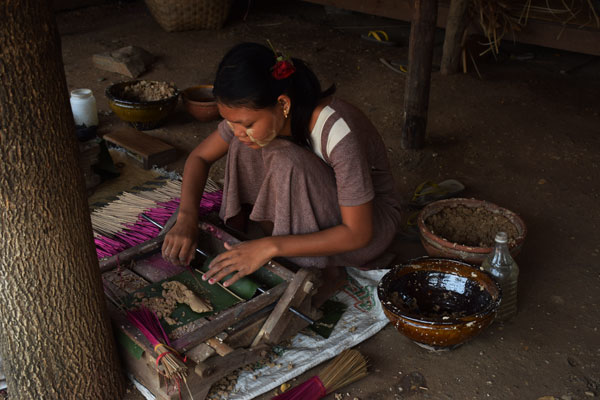
Thet village – Pottery village
Road trip between Monywa and Bagan is quite interesting. It takes just 3 and half hours if you drive without stopping. Cultural tourism in Myanmar will be more attractive stopping at the villages on road side and have a chat with villagers and enjoy staying with them for few minutes that reflect you their real style of living. Most Myanmar income is from agriculture. Every village has its famous local product apart from agriculture. There is a pottery village on the road side next to Mau ale village. Very dry and poor village. Quite interesting how they get raw material and still use traditional technology to make daily use clay products.

Yezagyo village
One of the famous places for incense that Myanmar widely uses as important offering items at the religious places. Villagers make just raw incense by using simple machine to combine with thin long bamboo stick with thanakha paste. Drying process is in front of their houses. One of the other famous regional product is Yezagyo rice cake. There are several places where local families make tasty rice cake. Stopping at their bakery house and see how they make it. It cost very little for rice cake tasting at the bakery.

Pakokku
Pakokku town is situated on the bank of Ayeyarwaddy River and just (30km) from Bagan. Before 2009, Pakokku bridge construction, all travelers from Monywa to Bagan, had to stop at Pakkoku and take the ferry boat cross the river for an hour. Then drive to Bagan. Some foreign travelers hired private boat to Bagan. Now a day, after Pakokku bridge construction, travel easily by road to Bagan.
Thanbodhay temple
Monywa Bodhitataung
Powin cave or Powin Taung
Kyaukka village and Shweguni pagoda
Monywa Mau Kyi village (snack village)
Mau ale village
Thet village – Pottery village
Yezagyo village

